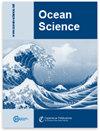海洋再分析中威德尔海的水团转化变率
IF 3.3
3区 地球科学
Q2 METEOROLOGY & ATMOSPHERIC SCIENCES
引用次数: 0
摘要
摘要本文研究了威德尔环流(WG)内水团转化(WMT)的变异性。WG是经向翻转环流(MOC)和海洋通风的关键站点,因为它是全球海洋中最大体积的水质量的主要来源:南极底水(AABW)。最近的系泊数据表明,离开WG的AABW属性存在大量的季节和年际变化,并且研究将这种变化与影响WG地区风应力的大尺度气候强迫联系起来。然而,将地表强迫的变异性与水质量转化和AABW输出的变异性联系起来的具体热力学机制仍不清楚。本研究探讨了当前最先进的数据同化海洋再分析如何通过从Walin的经典WMT框架中得出的WMT体积预算,帮助填补我们对WG中AABW变率的热力学驱动因素的理解空白。使用的三种海洋再分析是:估计环流和气候的海洋状态估计(ecco4)、南大洋状态估计(SOSE)和简单海洋资料同化(SODA)。从模型输出中,我们诊断出AABW的水质量预算的封闭形式,该形式明确地考虑了跨WG边界的输送、地表强迫、内部混合和数值混合。我们考察了WMT预算项的年平均气候学、季节气候学和年际变率。我们的发现表明,这些模型相对粗糙的分辨率并不能真实地捕捉到AABW的形成、输出和变化。在ECCO和sse中,我们看到AABW体积预算的年际变化很强。在SOSE,我们发现2005-2010年间AABW的加速损失,主要是由内部混合和地表盐通量的变化驱动的。ECCO在2007年末开始的4年期间显示了类似的趋势,但也表明这种趋势是年际变率的一部分,而且时间更长。总的来说,ECCO为理解驱动WMT的过程和机制提供了最有用的时间序列,并在WG中导出可变性。相比之下,SODA在AABW体积上表现出非物理上的大变异性,我们将其归因于其数据同化方案。我们还研究了WMT预算与大尺度气候指数(包括El Niño-Southern涛动(ENSO)和南环模(SAM))之间的相关性,发现没有很强的相关性。本文章由计算机程序翻译,如有差异,请以英文原文为准。
Water mass transformation variability in the Weddell Sea in ocean reanalyses
Abstract. This study investigates the variability of water mass transformation (WMT) within the Weddell Gyre (WG).
The WG serves as a pivotal site for the Meridional Overturning Circulation (MOC) and ocean ventilation because it is the primary origin of the largest volume of water mass in the global ocean: Antarctic Bottom Water (AABW).
Recent mooring data suggest substantial seasonal and interannual variability of AABW properties exiting the WG, and studies have linked the variability to the large-scale climate forcings affecting wind stress in the WG region.
However, the specific thermodynamic mechanisms that link variability in surface forcings to variability in water mass transformations and AABW export remain unclear.
This study explores how current state-of-the-art data-assimilating ocean reanalyses can help fill the gaps in our understanding of the thermodynamic drivers of AABW variability in the WG via WMT volume budgets derived from Walin's classic WMT framework. The three ocean reanalyses used are the following: Estimating the Circulation and Climate of the Ocean state estimate (ECCOv4), Southern Ocean State Estimate (SOSE) and Simple Ocean Data Assimilation (SODA).
From the model outputs, we diagnose a closed form of the water mass budget for AABW that explicitly accounts for transport across the WG boundary, surface forcing, interior mixing and numerical mixing.
We examine the annual mean climatology of the WMT budget terms, the seasonal climatology and finally the interannual variability. Our finding suggests that the relatively coarse resolution of these models did not realistically capture AABW formation, export and variability.
In ECCO and SOSE, we see strong interannual variability in AABW volume budget.
In SOSE, we find an accelerating loss of AABW during 2005–2010, driven largely by interior mixing and changes in surface salt fluxes.
ECCO shows a similar trend during a 4-year time period starting in late 2007 but also reveals such trends to be part of interannual variability over a much longer time period.
Overall, ECCO provides the most useful time series for understanding the processes and mechanisms that drive WMT and export variability in the WG.
SODA, in contrast, displays unphysically large variability in AABW volume, which we attribute to its data assimilation scheme.
We also examine correlations between the WMT budgets and large-scale climate indices, including El Niño–Southern Oscillation (ENSO) and Southern Annular Mode (SAM), and find no strong relationships.
求助全文
通过发布文献求助,成功后即可免费获取论文全文。
去求助
来源期刊

Ocean Science
地学-海洋学
CiteScore
5.90
自引率
6.20%
发文量
78
审稿时长
6-12 weeks
期刊介绍:
Ocean Science (OS) is a not-for-profit international open-access scientific journal dedicated to the publication and discussion of research articles, short communications, and review papers on all aspects of ocean science: experimental, theoretical, and laboratory. The primary objective is to publish a very high-quality scientific journal with free Internet-based access for researchers and other interested people throughout the world.
Electronic submission of articles is used to keep publication costs to a minimum. The costs will be covered by a moderate per-page charge paid by the authors. The peer-review process also makes use of the Internet. It includes an 8-week online discussion period with the original submitted manuscript and all comments. If accepted, the final revised paper will be published online.
Ocean Science covers the following fields: ocean physics (i.e. ocean structure, circulation, tides, and internal waves); ocean chemistry; biological oceanography; air–sea interactions; ocean models – physical, chemical, biological, and biochemical; coastal and shelf edge processes; paleooceanography.
 求助内容:
求助内容: 应助结果提醒方式:
应助结果提醒方式:


